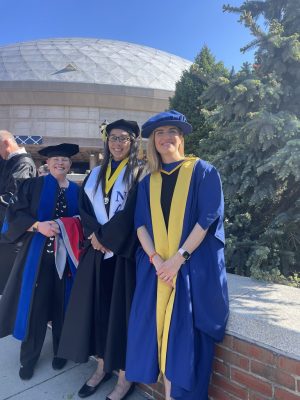2025 SURF Awards
The 2025 Summer Undergraduate Research Fund (SURF) Awards were announced and 15 out of 46 awardees are MCB students! These UConn students were selected from a strong
group of applicants representing diverse areas of academic inquiry.
Ava Anderson ’26 (Mathematics-Statistics & Molecular and Cell Biology, CLAS) Project Title: Expanding Intron Classification: Insights into Splice Variation and Evolution Faculty Mentor: Dr. Rahul Kanadia, Physiology and Neurobiology
Andrew Deierlein ’26 (Molecular and Cell Biology, CLAS & Pathobiology, CAHNR) Project Title: Let’s Move In! - Gene Families and the Transition to Endosymbiosis Faculty Mentor: Dr. Jill Wegrzyn, Ecology and Evolutionary Biology
Muhammad Faisal ’26 (Molecular and Cell Biology, CLAS) Project Title: Effect of Membrane Composition on the Binding of Certain Ligands to the 5-HT2A Receptor Faculty Mentor: Dr. Eric May, Molecular and Cell Biology
Abigail Goldhamer ’27 (Molecular and Cell Biology, CLAS) Project Title: Investigating the Effects of Matrimony and Polo Kinase Localization on B Chromosome
Transmission Faculty Mentor: Dr. Stacey Hanlon, Molecular and Cell Biology
Noen Jian ’26 (Molecular and Cell Biology & Chemistry, CLAS) Project Title: Synthetic Tuning to Achieve Air-Stable Molecular Qubits Faculty Mentor: Dr. Tomoyasu Mani, Chemistry
Ruupala Kalaiarasu ’27 (Molecular and Cell Biology, CLAS) Project Title: The Role(s) for Hox11 Genes in Expression of Prg4/lubricin by Articular Cartilage Progenitors Faculty Mentor: Dr. Danielle Rux, Orthopedic Surgery
Irena Komninakas ’26 (Molecular and Cell Biology & Spanish, CLAS) Project Title: Information Seeking Behavior of Pediatric Patients in the CT Children's Emergency Department Faculty Mentor: Dr. Sharon Smith, Pediatrics, School of Medicine
Aditi Malpure ’27 (Molecular and Cell Biology, CLAS) Project Title: Contribution of Adult Hippocampal Neurogenesis to Fear Generalization and Discrimination Faculty Mentor: Dr. Sebnem Nur Tuncdemir, Neuroscience
Abigail Messina ’26 (Molecular and Cell Biology, CLAS) Project Title: Cartilage Regenerative Approach for TMJ-Osteoarthritis in an In Vitro Model Faculty Mentor: Dr. Caroline Dealy, Orthodontics, Orthopedic Surgery & Cell Biology
Liv Nevo ’26 (Molecular and Cell Biology, CLAS) Project Title: Investing the Role of Activin A in Muscle Degeneration Caused in Fibrodysplasia Ossificans Progressiva Faculty Mentor: Dr. David Goldhamer, Molecular and Cell Biology
Vedansh Patel, Dec. ’25 (Molecular and Cell Biology, CLAS) Project Title: Investigating the Roles of Histone Modifications in Stem Cell Differentiation Faculty Mentor: Dr. Mayu Inaba-Oguro, Cell Biology
Luke Pratley ’26 (Molecular and Cell Biology, CLAS) Project Title: Sustained Release of Azobenzene Derivatives from Selectively Permeable Nanocapsules
Faculty Mentor: Dr. Eugene Pinkhassik, Chemistry
Mackenzie Robillard ’27 (Molecular and Cell Biology, CLAS) Project Title: Investigating the Connection Between LINE1 Transposable Elements and Neocentromere
Formation and Stability Faculty Mentor: Dr. Rachel O'Neill, Molecular and Cell Biology
Melissa Sabatella ’26 (Physiology and Neurobiology & Molecular and Cell Biology, CLAS) Project Title: Impact of Polymer Source Variation on the Properties and Performance of Long-Acting Injectable
Suspensions Faculty Mentor: Dr. Diane Burgess, Pharmaceutical Sciences
Alexandra Salem ’26 (Structural Biology/Biophysics, CLAS) Project Title: Characterize Anesthetic Sensitivity of a Mouse Model of Rett Syndrome Faculty Mentor: Dr. Daniel Mulkey, Physiology and Neurobiology
Jake Vaccarezza
2024/2025 Paul Drotch Scholarship
MCB Undergraduate student Sihlelelwe Dlamini has been awarded a Lt. Paul Drotch Undergraduate Biology Memorial Scholarship for 2024-2025. This award is available to students each year as a result of the thoughtfulness and generosity of Mr. Peter and Mrs. Hinda Drotch and their family, who established this award in memory of Mr. Drotch’s brother.
2025 MCB Undergraduate Research Colloquium Winners
The 11th Annual Undergraduate Research Colloquium in Molecular and Cell Biology took place on April 15 and 18, 2025. We received a record number of entries this year with a total of 14 participants. The top three presenters are 1st, Ryan Frier (Actin nucleation factors maintain genomic integrity and promote mitotic fidelity); 2nd, Erica Lavoie (The Epigenetic Regulator, Dot1L, Contributes to Neuropathology in Globoid Cell Leukodystrophy); and 3rd, Bianca Planeta Investigating the role of ORF1 in the transposition of the centromere-enriched retroelement G2/Jockey-3
MCB Students Win Undergraduate Research Symposium Awards
Outstanding Senior in MCB – Ryan Frier
Excellence in Applied Genetics and Technology – Erica Lavoie
Biological Sciences Director’s Award – Bianca Planeta
2025 University Scholars
Nora Lippai Investigating the Influence of Genomic Elements on Readthrough Transcription Committee: Leighton Core, Molecular and Cell Biology; Jelena Erceg, Molecular and Cell Biology; Kenneth Campellone, Molecular and Cell Biology
Jose Matute Calcium Modulation: Photoswitchable ML-9 Derivatives Committee: Michael Kienzler, Chemistry; Amy Howell, Chemistry; Christopher Malinoski, Molecular and Cell Biology
Laxmi Chinmaya Vobbineni The Synergic Role of Electrical and Chemical Stimulation in Wound Healing of Diabetic Patients Committee: Syam Nukavarapu, Biomedical Engineering; David Daggett, Molecular and Cell Biology; Sangamesh Kumbar, Biomedical Engineering
,










 MCB is proud to share that Carol Vieira Da Silva (Milligan-McClellan Lab) and Sarah Pasqualetti (Milligan-McClellan Lab) each placed first in their categories.
MCB is proud to share that Carol Vieira Da Silva (Milligan-McClellan Lab) and Sarah Pasqualetti (Milligan-McClellan Lab) each placed first in their categories.